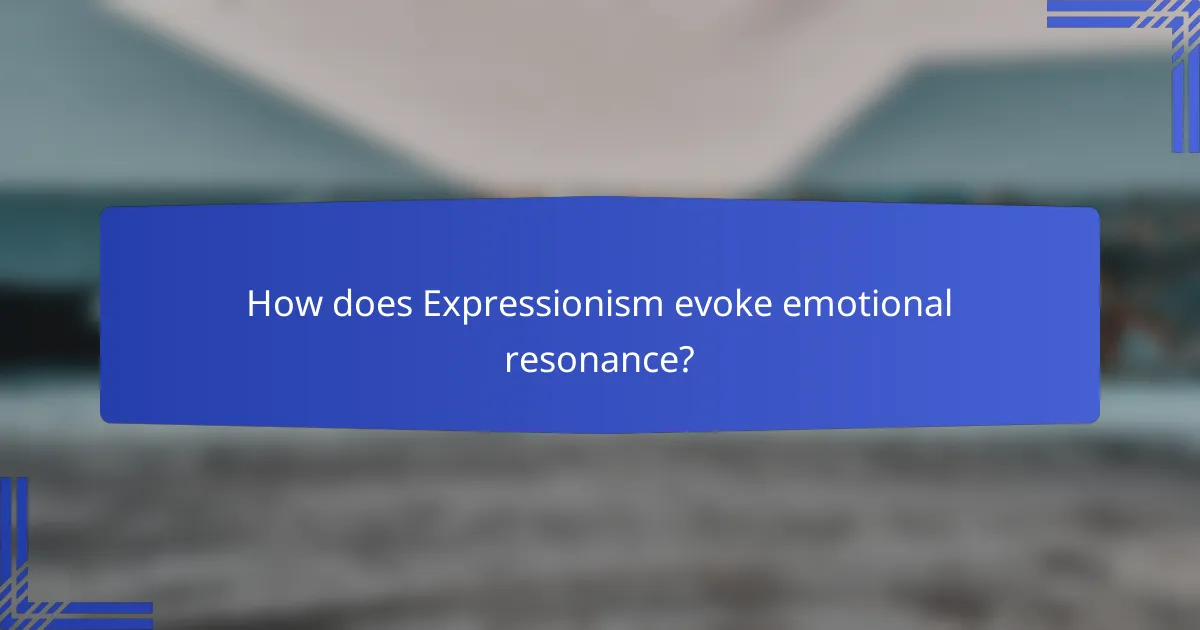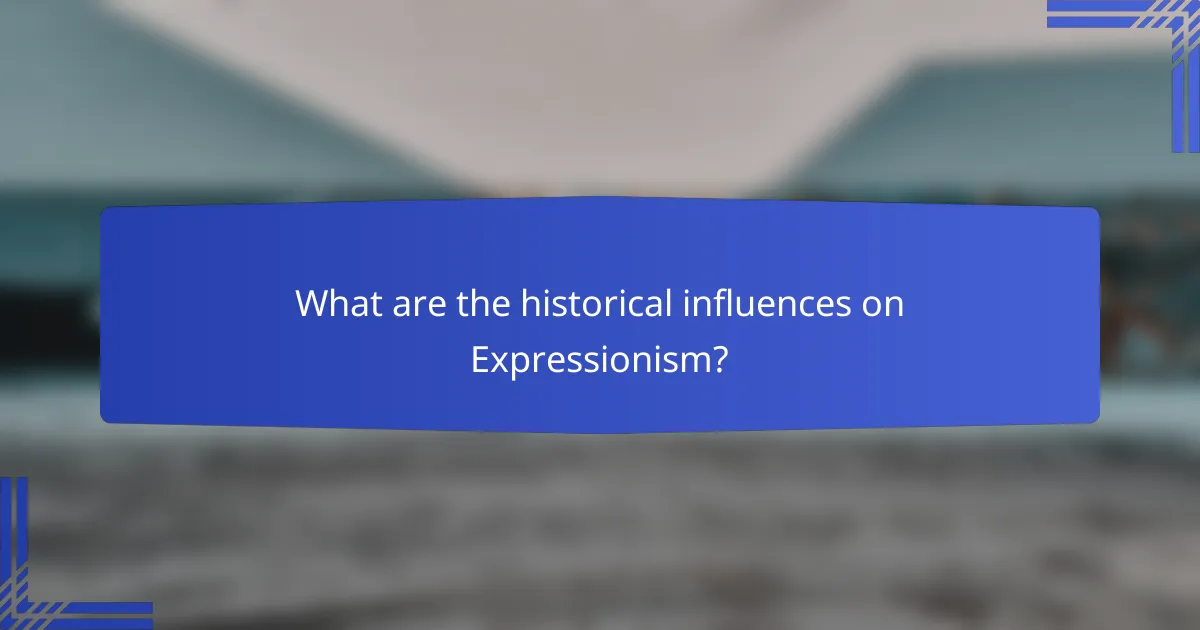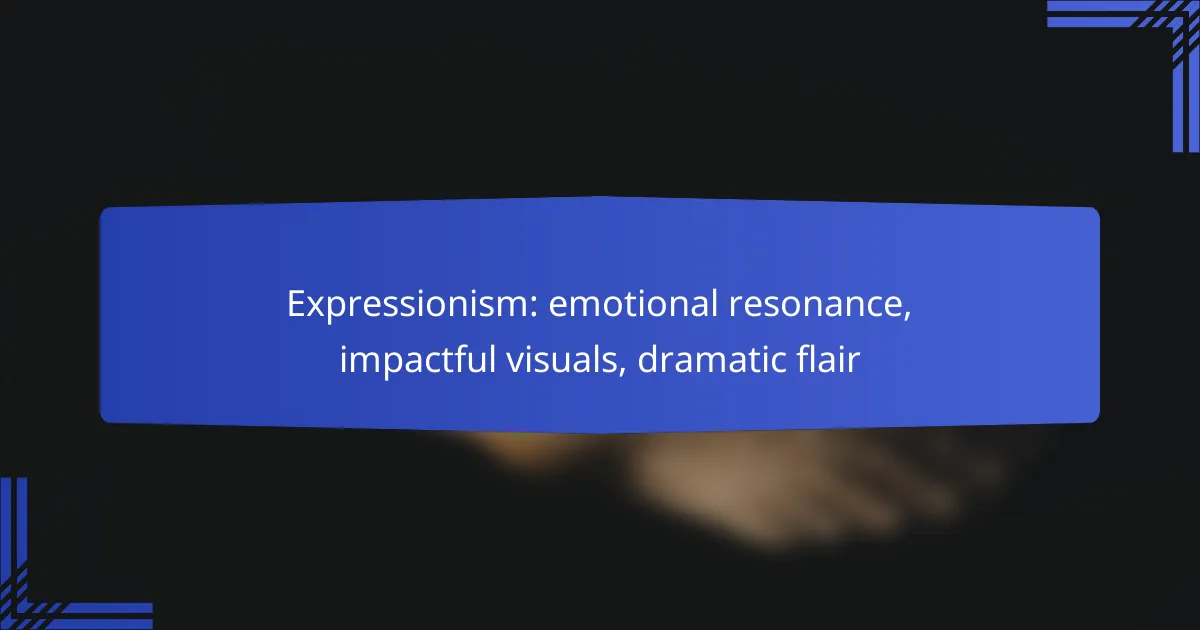Expressionism is an art movement that emphasizes emotional resonance, prioritizing subjective feelings over realistic representation. Through bold visuals and intense colors, it allows viewers to connect deeply with the artwork, often conveyed through exaggerated forms and dramatic flair. Key figures like Edvard Munch and Wassily Kandinsky exemplify this approach, creating pieces that evoke powerful emotions and narratives.

How does Expressionism evoke emotional resonance?
Expressionism evokes emotional resonance by prioritizing subjective feelings over realistic representation. This art movement uses bold visuals and intense colors to convey deep emotions, allowing viewers to connect with the artwork on a personal level.
Use of color psychology
Color psychology plays a crucial role in Expressionism, as different colors can elicit specific emotional responses. For instance, reds and oranges may evoke feelings of passion or anger, while blues and greens can create a sense of calm or sadness. Artists often choose colors deliberately to enhance the emotional impact of their work.
When creating or analyzing Expressionist art, consider how color combinations affect mood. A vibrant palette can energize a piece, while muted tones might convey melancholy. Understanding these associations can deepen your appreciation of the artwork’s emotional depth.
Subjective interpretations
Expressionism encourages subjective interpretations, allowing viewers to derive personal meanings from the artwork. Each individual may resonate differently with the same piece, influenced by their own experiences and emotions. This variability is a hallmark of the movement, fostering a unique connection between the art and the observer.
To engage with Expressionist art, reflect on your emotional reactions and thoughts as you view a piece. Consider what memories or feelings it stirs within you, as this personal engagement is central to the Expressionist experience.
Personal experiences
Personal experiences significantly shape how individuals respond to Expressionist art. Artists often draw from their own emotional journeys, translating feelings of joy, despair, or turmoil into their work. This authenticity can resonate powerfully with viewers who may have faced similar emotions.
When exploring Expressionism, think about how your own life experiences influence your interpretation. Sharing these insights with others can enrich discussions and deepen collective understanding of the emotional resonance embedded in the artwork.

What are the key characteristics of Expressionist art?
Expressionist art is characterized by its focus on emotional resonance, impactful visuals, and dramatic flair. It seeks to convey the artist’s subjective experience and feelings, often through exaggerated forms and vivid colors.
Dramatic use of color
Color in Expressionist art is often intense and non-representational, serving to evoke strong emotions rather than to accurately depict reality. Artists may use bold, contrasting colors to create a sense of urgency or turmoil, which can significantly influence the viewer’s emotional response.
For example, a painting might feature deep reds and vibrant yellows to express passion or anger, while cooler tones like blues and greens could convey sadness or introspection. This dramatic use of color is essential for establishing the mood of the artwork.
Distorted forms
Distortion of forms is a hallmark of Expressionism, where artists deliberately alter shapes and figures to reflect emotional states rather than physical accuracy. This can manifest as elongated limbs, exaggerated facial expressions, or abstract shapes that challenge conventional representation.
Such distortions serve to highlight the inner turmoil of the subjects, drawing attention to their psychological experiences. For instance, a figure might be depicted with an oversized head to symbolize overwhelming thoughts, creating a striking visual impact.
Emphasis on emotion
Expressionist art prioritizes emotional expression over realistic representation, aiming to connect with viewers on a deeper level. Artists often draw from personal experiences, societal issues, or existential themes, allowing their emotions to guide the creative process.
This emphasis on emotion can be seen in works that tackle themes of alienation, despair, or joy, inviting viewers to engage with the artwork not just visually but emotionally. The goal is to provoke a visceral reaction, making the viewer feel the intensity of the artist’s experience.

Which famous Expressionist artists should you know?
Key Expressionist artists include Edvard Munch, Wassily Kandinsky, and Egón Schiele, each known for their emotional depth and striking visual styles. Their works often convey intense feelings and dramatic narratives, making them pivotal figures in the Expressionist movement.
Edvard Munch
Edvard Munch is best known for his iconic painting “The Scream,” which encapsulates the essence of Expressionism through its vivid colors and emotional turmoil. His art often explores themes of love, anxiety, and death, reflecting his personal experiences and psychological struggles.
Munch utilized bold brushstrokes and contrasting colors to evoke strong emotional responses. His works encourage viewers to confront their own feelings, making them timeless pieces in the art world.
Wassily Kandinsky
Wassily Kandinsky is recognized as a pioneer of abstract art, using color and form to express emotions rather than represent reality. His belief that art should resonate with the viewer’s inner feelings led him to create compositions that are both visually striking and emotionally charged.
Kandinsky’s works often feature vibrant colors and geometric shapes, which he believed could evoke specific emotional responses. His approach encourages artists to explore the relationship between color and emotion, making his techniques relevant for contemporary creators.
Egón Schiele
Egón Schiele is known for his raw and provocative depictions of the human form, often highlighting themes of sexuality and existential angst. His distinctive style combines expressive line work with a focus on the psychological depth of his subjects.
Schiele’s use of distorted figures and bold colors challenges traditional representations of beauty, inviting viewers to engage with the complexities of human emotion. His work remains influential, inspiring discussions about identity and the human experience in art today.

How can you incorporate Expressionism into modern design?
Incorporating Expressionism into modern design involves using vivid colors, dynamic layouts, and emotional narratives to create impactful visuals. This approach emphasizes personal expression and dramatic flair, allowing designers to evoke strong feelings and reactions from their audience.
Bold color palettes
Utilizing bold color palettes is essential in Expressionist design. Bright, saturated colors can convey emotions and set the tone for a project. Consider using contrasting colors to create visual tension or to highlight key elements, ensuring that your color choices resonate with the intended message.
For example, a website for a wellness brand might use calming blues and greens, while a campaign for a music festival could employ vibrant reds and yellows. Aim for a limited palette of three to five colors to maintain coherence while still making a strong visual impact.
Dynamic compositions
Dynamic compositions are a hallmark of Expressionism, characterized by unusual layouts and asymmetry. This approach can draw the viewer’s eye and create a sense of movement within the design. Experiment with layering elements, using diagonal lines, and breaking traditional grid structures to enhance visual interest.
When designing a poster, for instance, consider placing text at an angle or overlapping images to create depth. Remember that the goal is to evoke emotion, so let the composition reflect the energy and mood of the subject matter.
Emotional storytelling
Emotional storytelling is crucial in Expressionist design, as it connects the audience to the message on a deeper level. Use visuals, typography, and imagery that resonate with the emotions you want to convey. This could involve selecting images that tell a story or using typography that reflects the emotional tone of the content.
For example, a charity campaign might feature poignant imagery of individuals affected by the cause, paired with heartfelt messaging. Always consider how each design element contributes to the overall narrative and emotional impact, ensuring that viewers feel engaged and moved by the story being told.

What are the historical influences on Expressionism?
Expressionism emerged as a reaction to the emotional restraint of earlier art movements, drawing from various historical influences that shaped its distinctive style. Key influences include Post-Impressionism and Symbolism, both of which contributed to the movement’s focus on emotional resonance and impactful visuals.
Post-Impressionism
Post-Impressionism, which developed in the late 19th century, emphasized personal expression and a departure from realistic representation. Artists like Vincent van Gogh and Paul Cézanne used bold colors and dynamic forms to convey emotional depth, laying the groundwork for Expressionism’s dramatic flair.
This movement encouraged artists to explore their inner feelings and perceptions rather than merely depicting the external world. The use of vivid colors and exaggerated forms became a hallmark of Expressionist art, allowing for a more subjective interpretation of reality.
Symbolism
Symbolism, which flourished in the late 19th century, focused on representing ideas and emotions through symbolic imagery rather than direct representation. This movement influenced Expressionism by encouraging artists to delve into the subconscious and explore themes of spirituality, dreams, and the human condition.
Symbolist artists like Gustave Moreau and Odilon Redon used dream-like imagery and allegorical subjects, which resonated with Expressionist ideals. The emphasis on emotional experience over literal depiction helped pave the way for the bold, evocative works characteristic of Expressionism.
